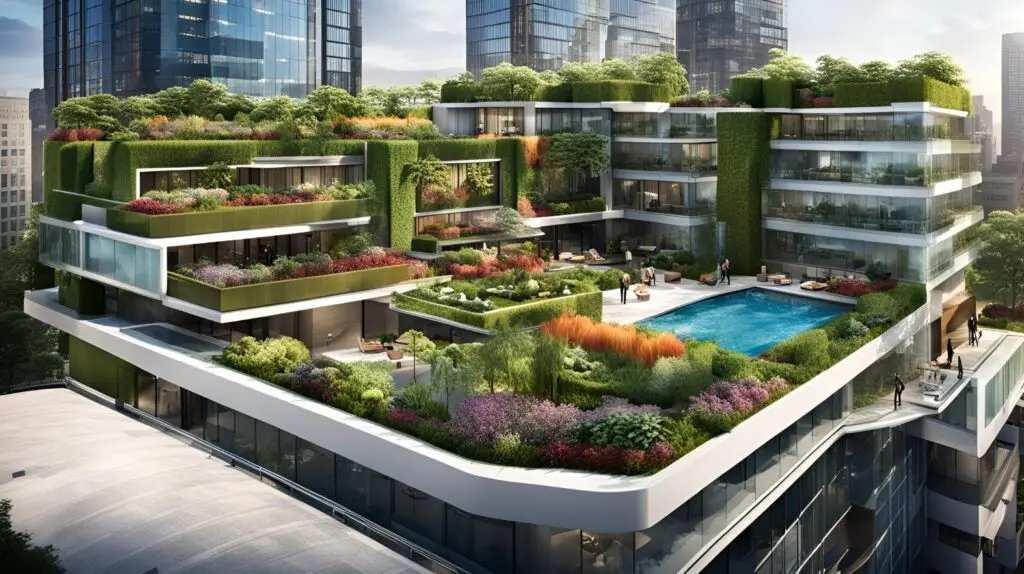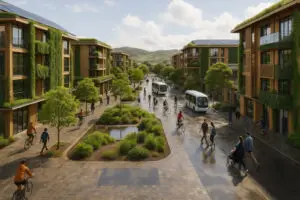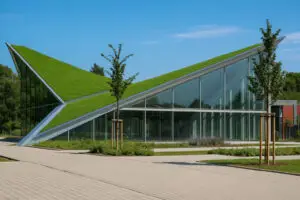Eco Infrastructure Developments Tech

Eco Infrastructure Developments Tech traces the shift from single-purpose grey assets to multi functional green–blue systems. Consequently, cities now enhance resilience, climate mitigation, and community well-being through nature-based networks. The report draws on 2023–2025 evidence from Australia, New Zealand, and peer global cities. It synthesizes design advances, economic proofs, and governance trends that support mainstream adoption.
Recent innovations and Australasian case studies
Modular green facades, day lighted streams, and flood able parks exemplify the new toolkit. For instance, Adelaide’s Pasadena Biodiversity Corridor channels treated storm water through a 300-meter creek and cools nearby streets (Water Technology, 2023). Furthermore, Auckland’s NZ$1 billion Blue-Green Network redesigns parks as temporary flood ways after the 2023 storms. Meanwhile, Sydney’s incentives accelerate vertical gardens across the CBD. Melbourne’s Green Factor Tool still rewards projects that integrate trees, rain gardens, and productive roofs. Together, these cases unite ecological performance with social amenity and confirm that Eco-infrastructure is core city hardware.
Economic rationale, funding, and maintenance Eco Infrastructure Developments Tech
Cost-benefit analyses consistently show benefit–cost ratios above one for urban nature-based solutions (npj Urban Sustainability 2024). Moreover, three factors guide investment decisions:
- Life cycle value. Avoided flood damage, lower cooling demand, and health gains outweigh higher upfront costs.
- Diversified funding. Green bonds, ESG-linked loans, and storm-water fees anchor long-term capital programmers; Melbourne, Auckland, and Los Angeles issued certified green bonds in 2023.
- Maintenance strategies. Many municipalities now classify the intensive establishment phase as capital cost, thereby unlocking infrastructure finance and easing operating budgets.
Additionally, diverse native plant palettes cut upkeep by boosting pest resistance and supporting self-regulating ecosystems, as United States Forest Service research notes (USFS).
Resilience co-benefits and technological integration
Eco Infrastructure Developments Tech supports four critical resilience pillars:
- Flood attenuation. Wetlands, swales, and room-for-the-river set-backs lower peak flows; during Hurricane Sandy, wetlands avoided an estimated US$625 million in damages (White House NBS Roadmap).
- Heat mitigation. Increasing canopy by ten percent can trim mean city temperatures by about one degree; Sydney plans at least twenty percent cover in every suburb by 2027.
- Air-quality gains. Urban trees in the United States remove 711,000 tonnes of pollutants each year, saving US$18.3 billion in health and energy costs (USFS).
- Biodiversity uplift. Wellington’s Zealandia corridor showcases city-scale rewilding, enabling native birds to travel from sanctuary to coast.
Consequently, digital twins and IoT sensors underpin adaptive management. Melbourne overlays canopy, heat, and income data to target plantings, whereas Lisbon models flood reduction from new wetlands within its city twin (Reuters 2024). Predictive algorithms then flag under-performing rain gardens, allowing pre-emptive maintenance.
Policy trajectory to 2027 Eco Infrastructure Developments Tech
National and local frameworks now embed Eco Infrastructure Developments Tech standards. For example, Victoria mandates on-site vegetated storm-water treatment for major developments, while New Zealand’s Resource Management reforms elevate nature-based solutions in consent decisions. Meanwhile, the EU Nature Restoration Law sets binding canopy targets, and U.S. federal grant scoring rewards natural flood controls. Therefore, dedicated cross-agency units—from New York’s Climate Resilience Bureau to Australia’s Nature-Based Solutions Task force—break organisational silos and promote integrated delivery.
Next steps. Practitioners should align project pipelines with green-bond markets, integrate sensor networks for evidence-based management, and adopt biodiversity-rich plant palettes to cut long-term O&M costs. Coordinated governance and transparent benefit accounting will, therefore, accelerate mainstreaming across the 2025-2027 horizon.
Technical

Better-Cities Healthier Communities Tech
Technical Review – Better Cities, Healthier Communities Better Cities Healthier Communities Tech now defines best practice in Western urban planning. The phrase captures a measurable goal: align land-use, mobility, and public space policies with population health, equity, and sustainability indicators. Health-Promoting Infrastructure Cities increasingly treat transport corridors, parks, and housing

Green Rooftops Gardens Tech
Technical assessment of Green living Rooftops Gardens in Australia and New Zealand, 2023-2025 Green Rooftops Gardens Tech have shifted from experimental showcases to mainstream infrastructure between 2023 and 2025, offering above all measurable hydro logical, thermal, and ecological services that address pressing urban stresses in Australia and New Zealand. Performance

Walls Vertical Gardens Tech
Living Walls Vertical Gardens – a Technical Synthesis for Australasian Cities Walls Vertical Gardens Tech integrate also vegetation, substrate, and irrigation into building skins, creating active thermal buffers, bio filters, and biodiversity corridors. This concise report reviews 2023–2025 research subsequently and practice in New Zealand and Australia, offering engineers and